Comparative Transcriptome Analysis of Two Peach Rootstocks Uncovers the Effect of Gene Differential Expression on Nitrogen Use Efficiency
Abstract
1. Introduction
2. Results
2.1. The Different NUE between Shannong–1 and Maotao
2.2. Transcriptome Sequence Analysis of Shannong–1 and Maotao
2.3. Function Annotation for the DEGs
2.4. Analysis of DEGs Involved in Nitrogen Metabolism of Peach Rootstocks
2.5. Phenotypic Characterization of OE-PpNRT2.1 Arabidopsis
3. Discussion
4. Materials and Methods
4.1. Materials for Determination of NUE
4.2. Determination of Root Vigor
4.3. Measurement of NUE
4.4. Materials for the Construction of cDNA Libraries
4.5. RNA Extraction and cDNA Synthesis
4.6. RNA Sequence Analysis
4.7. Gene Functional Annotation
4.8. Quantitative RT-PCR (qRT-PCR) Analysis
4.9. Plant Material and Growth Conditions
4.10. Construction of Plant Expression Vector, Arabidopsis Transformation and Characterization of Transgenic Plants
4.11. Statistical Analysis
5. Conclusions
Supplementary Materials
Author Contributions
Funding
Institutional Review Board Statement
Informed Consent Statement
Data Availability Statement
Conflicts of Interest
Abbreviations
References
- Rong, N.; Han, Y.L.; Rong, X.M.; Song, H.X.; Peng, J.W.; Xie, G.X.; Zhang, Y.P.; Zhang, Z.H. Response of NO3– uptake and distribution and nitrogen use efficiency in oilseed rape to limited nitrogen stress. J. Plant Nutr. Fertil. 2017, 23, 1104–1111. [Google Scholar]
- Masclaux-Daubresse, C.; Daniel-Vedele, F.; Dechorgnat, J.; Chardon, F.; Gaufichon, L.; Suzuki, A. Nitrogen uptake, assimilation and remobilization in plants: Challenges for sustainable and productive agriculture. Ann. Bot. 2010, 105, 1141–1157. [Google Scholar] [CrossRef]
- Grahmann, K.; Govaerts, B.; Fonteyne, S.; Guzman, C.; Soto, A.P.G.; Buerkert, A.; Verhulst, N. Nitrogen fertilizer placement and timing affects bread wheat (Triticum aestivum) quality and yield in an irrigated bed planting system. Nutr. Cycl. Agroecosyst. 2016, 106, 185–199. [Google Scholar] [CrossRef]
- Gu, X.B.; Li, Y.N.; Du, Y.D.; Zhou, C.M.; Yin, M.H.; Yang, D. Effects of water and nitrogen coupling on nitrogen nutrition index and radiation use efficiency of winter oilseed rape (Brassica napus L.). Trans. Chin. Soc. Agric. Macheny 2016, 47, 122–132. [Google Scholar]
- Hodge, A.; Robinson, A.; Fitter, A.H. An arbuscular mycorrhizal inculum enhances root proliferation in, but not nitrogen capture from, nutrient-rich patches in soil. New Phytol. 2000, 145, 575–584. [Google Scholar] [CrossRef]
- Krouk, G.; Lacombe, B.; Bielach, A.; Perrine-Walker, F.; Malinska, K.; Mounier, E.; Hoyerova, K.; Tillard, P.; Leon, S.; Ljung, K.; et al. Nitrate-Regulated Auxin Transport by NRT1.1 Defines a Mechanism for Nutrient Sensing in Plants. Dev. Cell 2010, 18, 927–937. [Google Scholar] [CrossRef] [PubMed]
- Aslam, M.; Travis, R.L.; Huffaker, R.C. Comparative Kinetics and Reciprocal Inhibition of Nitrate and Nitrite Uptake in Roots of Uninduced and Induced Barley (Hordeum vulgare L.) Seedlings. Plant Physiol. 1992, 99, 1124–1133. [Google Scholar] [CrossRef] [PubMed]
- Ludewig, U.; von Wiren, N.; Frommer, W.B. Uniport of NH4+ by the root hair plasma membrane ammonium transporter LeAMT1;1. J. Biol. Chem. 2002, 277, 13548–13555. [Google Scholar] [CrossRef] [PubMed]
- Daniel-Vedele, F.; Filleur, S.; Caboche, M. Nitrate transport: A key step in nitrate assimilation. Curr. Opin. Plant Biol. 1998, 1, 235–239. [Google Scholar] [CrossRef]
- Forde, B.G. Local and long-range signaling pathways regulating plant responses to nitrate. Annu. Rev. Plant Biol. 2002, 53, 203–224. [Google Scholar] [CrossRef] [PubMed]
- Tsay, Y.-F.; Chiu, C.-C.; Tsai, C.-B.; Ho, C.-H.; Hsu, P.-K. Nitrate transporters and peptide transporters. FEBS Lett. 2007, 581, 2290–2300. [Google Scholar] [CrossRef]
- Tsay, Y.F.; Schroeder, J.I.; Feldman, K.A.; Crawford, N.M. The herbicide sensitivity gene CHL1 of Arabidopsis encodes a nitrate-inducible nitrate transporter. Cell 1993, 72, 705–713. [Google Scholar] [CrossRef]
- Van Gelderen, K.; Kang, C.; Li, P.; Pierik, R. Regulation of Lateral Root Development by Shoot-Sensed Far-Red Light via HY5 Is Nitrate-Dependent and Involves the NRT2. 1 Nitrate Transporter. Front. Plant Sci. 2021, 12, 660870. [Google Scholar] [CrossRef]
- Little, D.Y.; Rao, H.; Oliva, S.; Daniel-Vedele, F.; Krapp, A.; Malamy, J.E. The putative high-affinity nitrate transporter NRT2.1 represses lateral root initiation in response to nutritional cues. Proc. Natl. Acad. Sci. USA 2005, 102, 13693–13698. [Google Scholar] [CrossRef]
- Zou, L.; Qi, D.; Sun, J.; Zheng, X.; Peng, M. Expression of the cassava nitrate transporter NRT2.1 enables Arabidopsis low nitrate tolerance. J. Genet. 2019, 98, 74. [Google Scholar] [CrossRef]
- Nazoa, P.; Vidmar, J.J.; Tranbarger, T.J.; Mouline, K.; Damiani, I.; Tillard, P.; Zhuo, D.; Glass, A.D.; Touraine, B. Regulation of the nitrate transporter gene AtNRT2.1 in Arabidopsis thaliana: Responses to nitrate, amino acids and developmental stage. Plant Mol. Biol. 2003, 52, 689–703. [Google Scholar] [CrossRef]
- Orsel, M.; Chopin, F.; Leleu, O.; Smith, S.J.; Krapp, A. Characterization of a two-component high-affinity nitrate uptake system in Arabidopsis. Physiology and protein-protein interaction. Plant Physiol. 2006, 142, 1304–1317. [Google Scholar] [CrossRef] [PubMed]
- Muro-Pastor, M.I.; Reyes, J.; Florencio, F.J. Ammonium assimilation in cyanobacteria. Photosynth Res. 2005, 83, 135–150. [Google Scholar] [CrossRef]
- Leblanc, A.; Renault, H.; Lecourt, J.; Etienne, P.; Deleu, C.; Le Deunff, E. Elongation changes of exploratory and root hair systems induced by aminocyclopropane carboxylic acid and aminoethoxyvinylglycine affect nitrate uptake and BnNrt2.1 and BnNrt1.1 transporter gene expression in oilseed rape. Plant Physiol. 2008, 146, 1928–1940. [Google Scholar] [CrossRef]
- Zheng, D.C.; Han, X.; An, Y.; Guo, H.W.; Xia, X.L.; Yin, W.L. The nitrate transporter NRT2.1 functions in the ethylene response to nitrate deficiency in Arabidopsis. Plant Cell Environ. 2013, 36, 1328–1337. [Google Scholar] [CrossRef] [PubMed]
- He, X.; Qu, B.; Li, W.; Zhao, X.; Teng, W.; Ma, W.; Ren, Y.; Li, B.; Li, Z.; Tong, Y. The nitrate-inducible NAC transcription factor TaNAV2-5A controls Nitrate response and increases wheat yield. Plant Physiol. 2015, 169, 1991–2005. [Google Scholar] [PubMed]
- Tang, W.; Ye, J.; Yao, X.; Zhao, P.; Xuan, W.; Tian, Y.; Zhang, Y.; Xu, S.; An, H.; Chen, G.; et al. Genome-wide associated study identifies NAC42-activated nitrate transporter conferring high nitrogen use efficiency in rice. Nat. Commun. 2019, 10, 5279. [Google Scholar] [CrossRef] [PubMed]
- de Paula, B.V.; Marques, A.C.R.; Rodrigues, L.A.T.; de Souza, R.O.S.; Kulmann, M.S.D.S.; Kaminski, J.; Ceretta, C.A.; de Melo, G.W.B.; Mayer, N.A.; Antunes, L.E.; et al. Morphological and kinetic parameters of the uptake of nitrogen forms in clonal peach rootstocks. Sci. Hortic. 2018, 239, 205–209. [Google Scholar] [CrossRef]
- Rufat, J.; Domingo, X.; Arbonés, A.; Pascual, M.; Villar, J.M. Interaction between water and nitrogen management in peaches for processing. Irrig. Sci. 2010, 29, 321–329. [Google Scholar] [CrossRef]
- Ferreira, L.V.; Picolotto, L.; Gonçalves, M.A.; Valgas, R.A.; Antunes, L.E.C. Fertilizer maintenance nitrogen in vegetative development and production of peach. Braz. J. Agric.-Rev. de Agric. 2018, 93, 80–92. [Google Scholar] [CrossRef]
- An, G.Y.; Fan, C.H.; Du, Z.H.; Yu, J.Y.; Deng, F.C.; Shi, L.R. Analysis of effective factors of nutrient content in apple leaves. Acta Hortic. Sin. 2006, 1, 12–16. [Google Scholar]
- Xia, Y.; Shen, H.Y.; Yao, Y.Q.; Liu, S.Z.; Ge, S.F. Study on the characteristics of uptake, distribution and utilization of 15N-labeled nitrate and ammonium in four pear rootstocks. Acta Hortic. Sin. 2017, 44, 2454. [Google Scholar]
- Jagesh, K.T.; Tanuja, B.; Sapna, D.; Shivangi, V.; Sarika, S.; Virupaksh, U.P.; Rasna, Z.; Nilofer, A.; Vaishali, M.; Rajesh, K.S.; et al. Physiological and genome-wide RNA-sequencing analyses identify candidate genes in a nitrogen-use efficient potato cv.Kufri Gaurav. Plant Physiol. Biochem. 2020, 154, 171–183. [Google Scholar]
- Remans, T.; Nacry, P.; Pervent, M.; Girin, T.; Tillard, P.; Lepetit, M.; Gojon, A. A Central Role for the Nitrate Transporter NRT2.1 in the Integrated Morphological and Physiological Responses of the Root System to Nitrogen Limitation in Arabidopsis. Plant Physiol. 2006, 140, 909–921. [Google Scholar] [CrossRef]
- Li, J.-Y.; Fu, Y.-L.; Pike, S.M.; Bao, J.; Tian, W.; Zhang, Y.; Chen, C.-Z.; Zhang, Y.; Li, H.-M.; Huang, J.; et al. The Arabidopsis Nitrate Transporter NRT1.8 Functions in Nitrate Removal from the Xylem Sap and Mediates Cadmium Tolerance. Plant Cell 2010, 22, 1633–1646. [Google Scholar] [CrossRef]
- Wang, Y.; Tsay, Y. Arabidopsis nitrate transporter NRT1.9 is important in phloem nitrate transport. Plant Cell 2011, 23, 1945–1957. [Google Scholar] [CrossRef] [PubMed]
- Tian, Q.; Sun, P.; Zhang, W. Ethylene is involved in nitrate-dependent root growth and branching in Arabidopsis thaliana. New Phytol. 2009, 184, 918–931. [Google Scholar] [CrossRef] [PubMed]
- Llamas, A.; Rexach, J.; Fernández, E.; Galvan, A. The activity of the high-affinity nitrate transport system I (NRT2;1, NAR2) is responsible for the efficient signalling of nitrate assimilation genes in Chlamydomonas reinhardtii. Planta 2002, 215, 606–611. [Google Scholar] [CrossRef]
- Hua, Y.P.; Zhou, T.; Song, H.X.; Guan, C.Y.; Zhang, Z.H. Integrated genomic and transcriptomic insights into the two-component high-affinity nitrate transporters in allotetraploid rapeseed. Plant Soil 2018, 427, 245–268. [Google Scholar] [CrossRef]
- Rubin, G.; Tohge, T.; Matsuda, F.; Saito, K.; Scheible, W.R. Members of the LBD family of transcription factors repress anthocyanin synthesis and affect additional nitrogen responses in Arabidopsis. Plant Cell 2009, 21, 3567–3584. [Google Scholar] [CrossRef]
- Vidal, E.A.; Moyano, T.C.; Riveras, E.; Contreras-López, O.; Gutiérrez, R.A. Systems approaches map regulatory networks downstream of the auxin receptor AFB3 in the nitrate response of Arabidopsis thaliana roots. Proc. Natl. Acad. Sci. USA 2013, 110, 12840–12845. [Google Scholar] [CrossRef] [PubMed]
- Alvarez, J.M.; Riveras, E.; Vidal, E.A.; Gras, D.E.; Contreras-López, O.; Tamayo, K.P.; Aceituno, F.; Gómez, I.; Ruffel, S.; Lejay, L.; et al. Systems approach identifies TGA1 and TGA4 transcription factors as important regulatory components of the nitrate response of Arabidopsis thaliana roots. Plant J. 2014, 80, 1–13. [Google Scholar] [CrossRef] [PubMed]
- Zhang, Y.F.; Luo, J.J.; Peng, F.T.; Wang, G.D.; Gao, H.F. Fulvic acid potassium and nutrient-controlled release paperbag enhance peach tree growth, nitrogen absorption and utilization. J. Plant Nutr. Fertil. 2017, 23, 998–1005. [Google Scholar]
- Khairul-Anuar, M.; Mazumdar, P.; Lau, S.; Tan, T.T.; Harikrishna, J. High-quality RNA isolation from pigment-rich Dendrobium Flowers. 3 Biotech. 2019, 9, 371. [Google Scholar] [CrossRef]
- Love, M.I.; Huber, W.; Anders, S. Moderated estimation of fold change and dispersion for RNA-seq data with DESeq2. Genome Biol. 2014, 15, 550. [Google Scholar] [CrossRef]
- Tong, Z.; Gao, Z.; Wang, F.; Zhou, J.; Zhang, Z. Selection of reliable reference genes for gene expression studies in peach using real-time PCR. BMC Mol. Biol. 2009, 10, 71. [Google Scholar] [CrossRef] [PubMed]
- Bechtold, N.; Ellis, J.; Pelletier, G. In planta Agrobacterium mediated gene transfer by infiltration of adult Arabidopsis thaliana plants. CR Acad. Sci. Paris Life Sci. 1993, 316, 1194–1199. [Google Scholar]
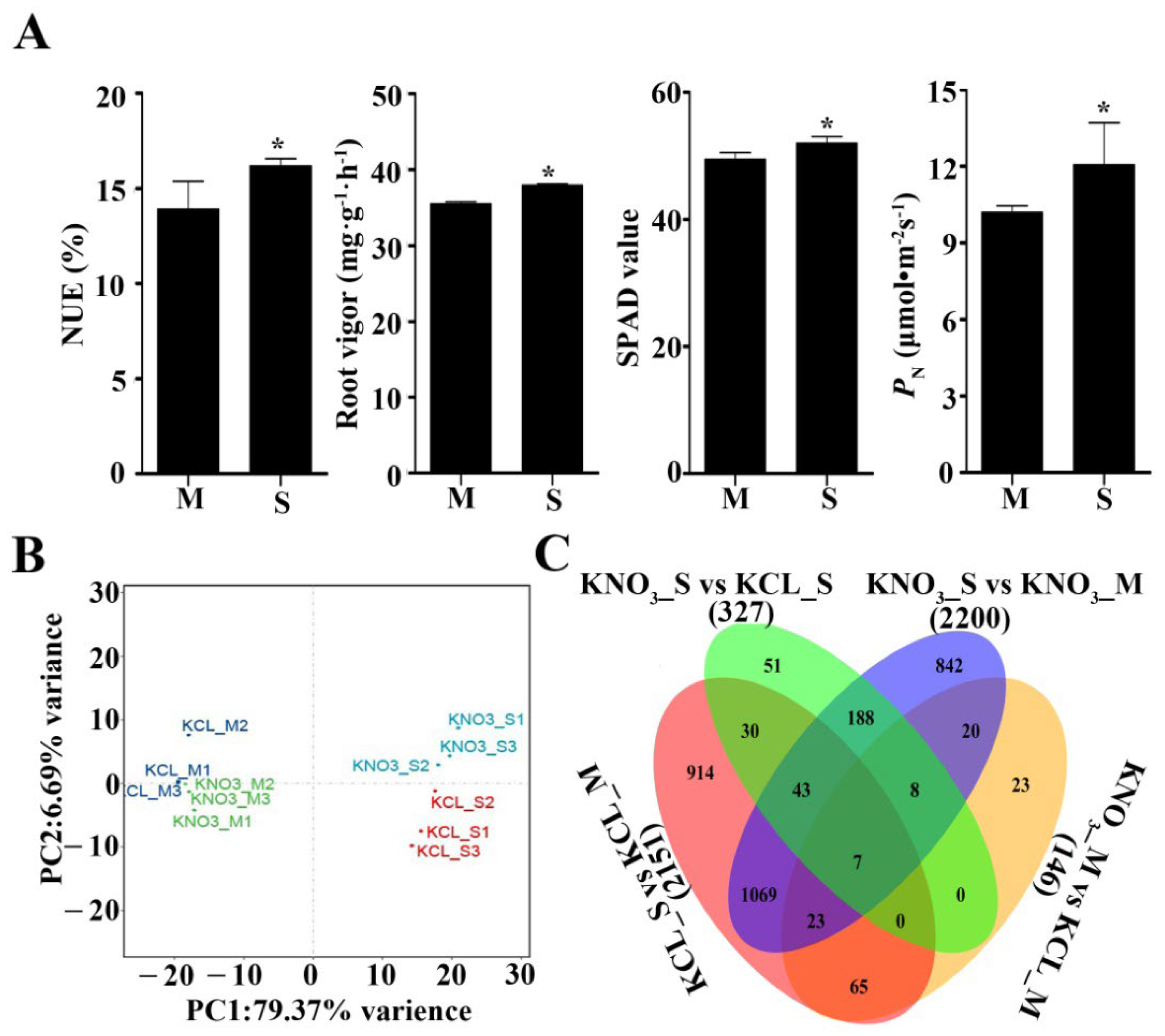
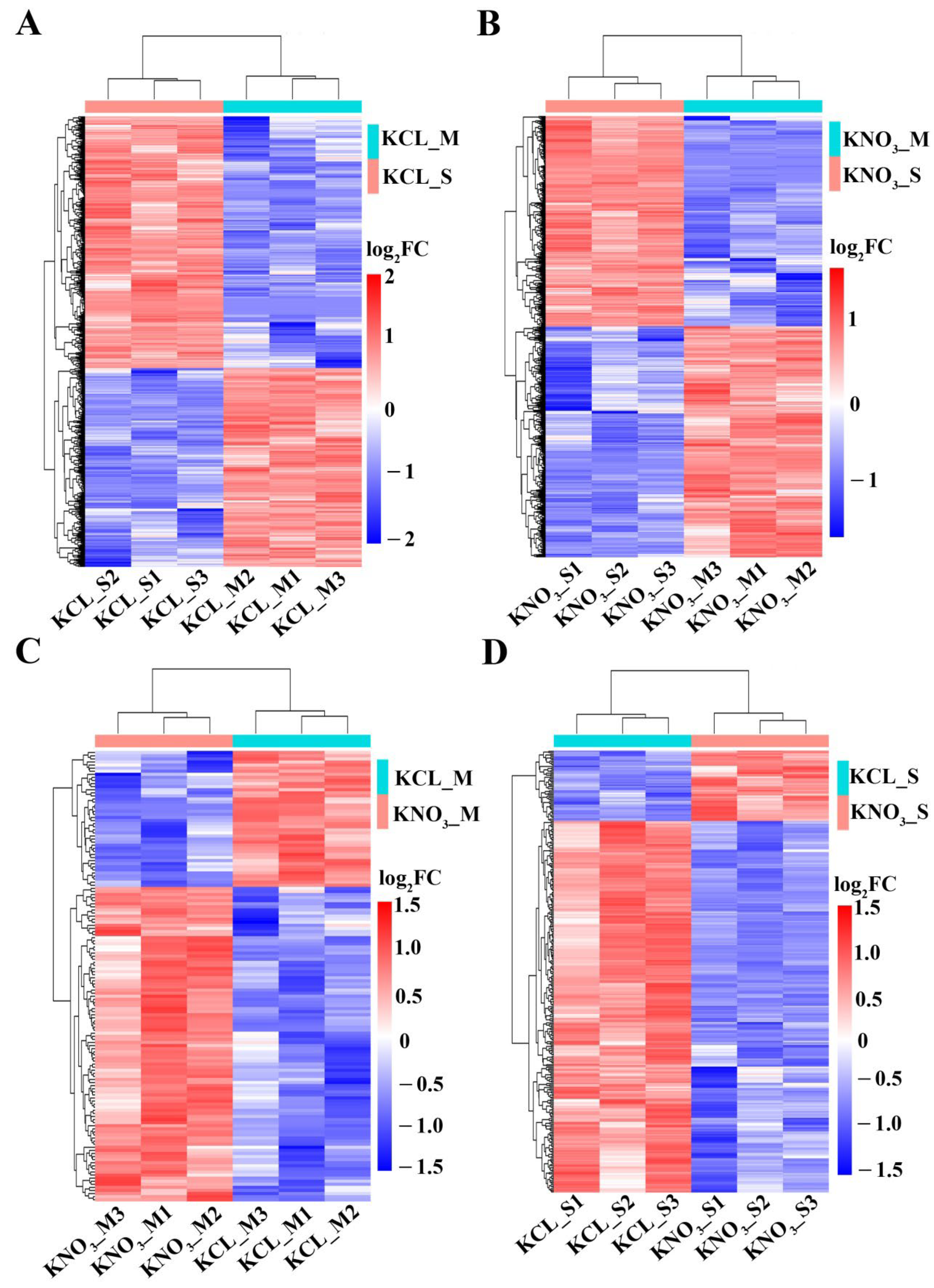
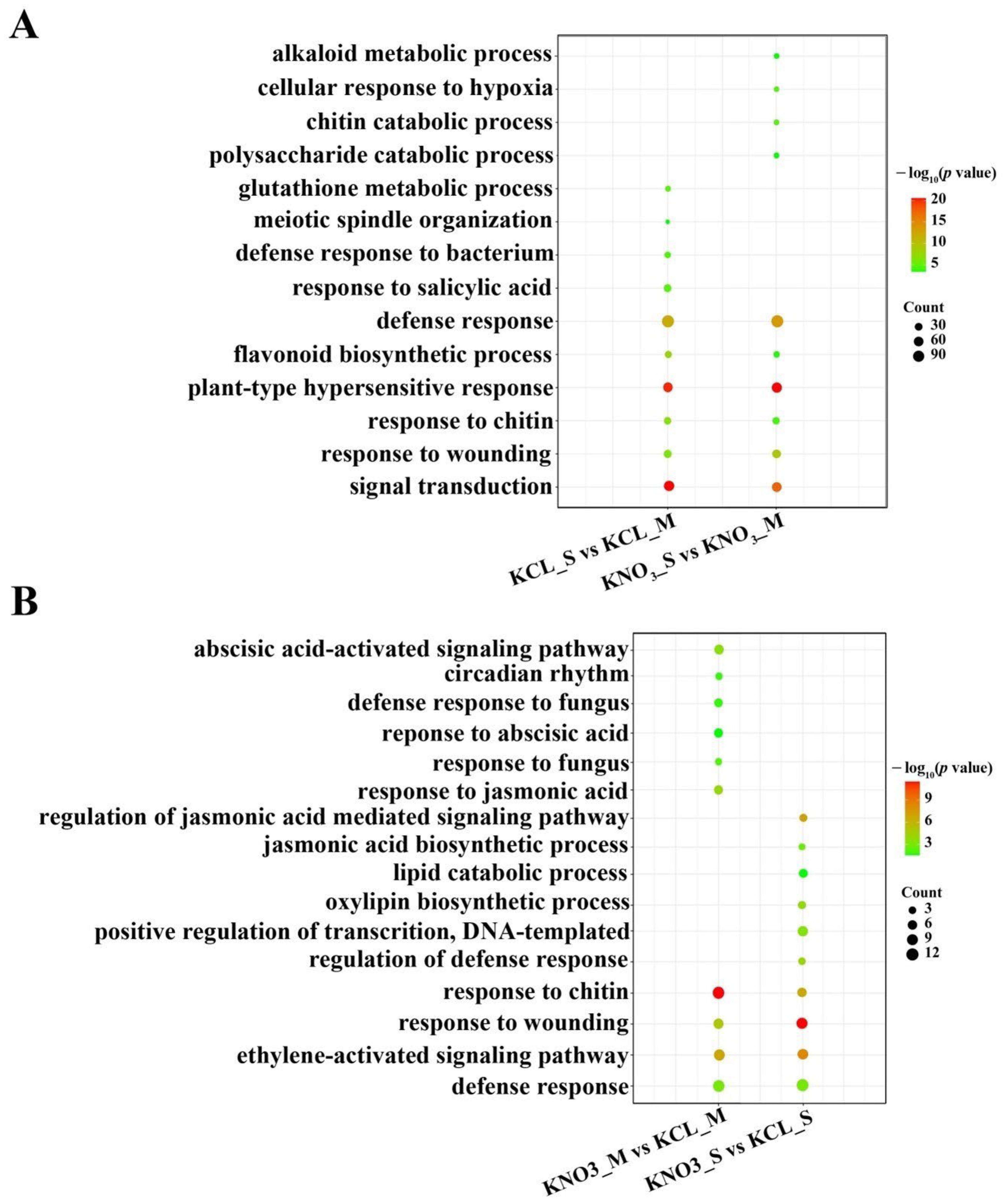
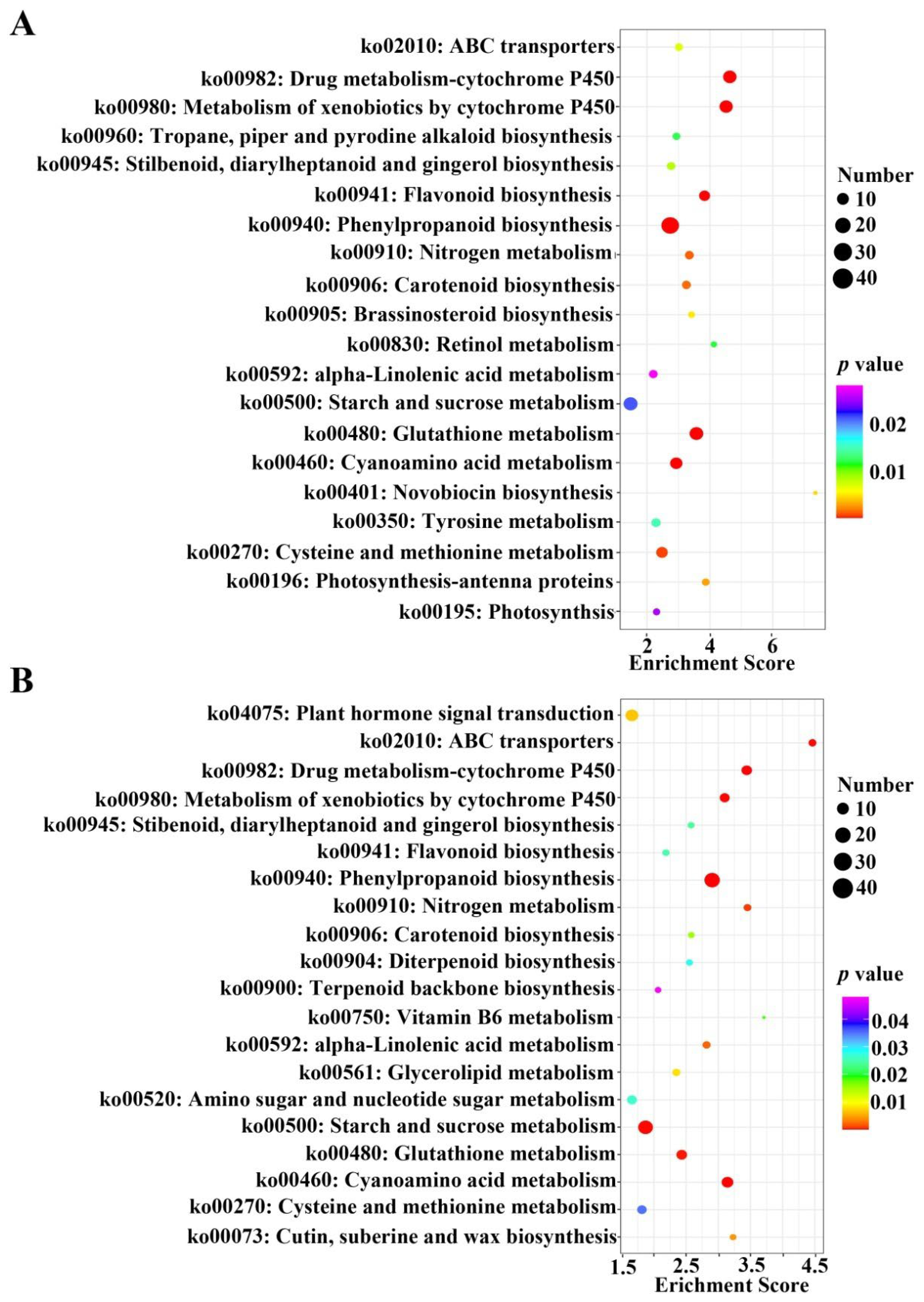
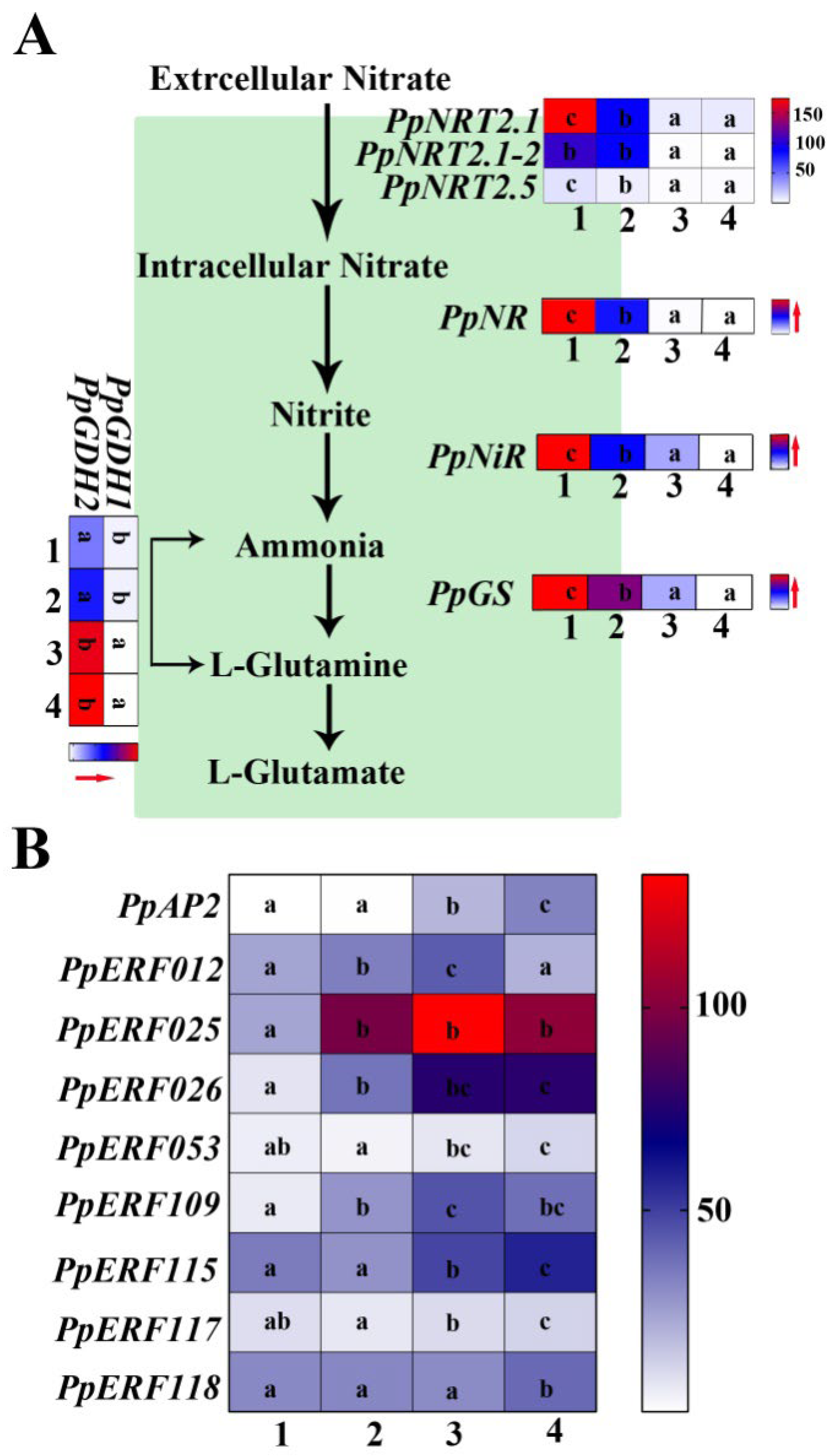
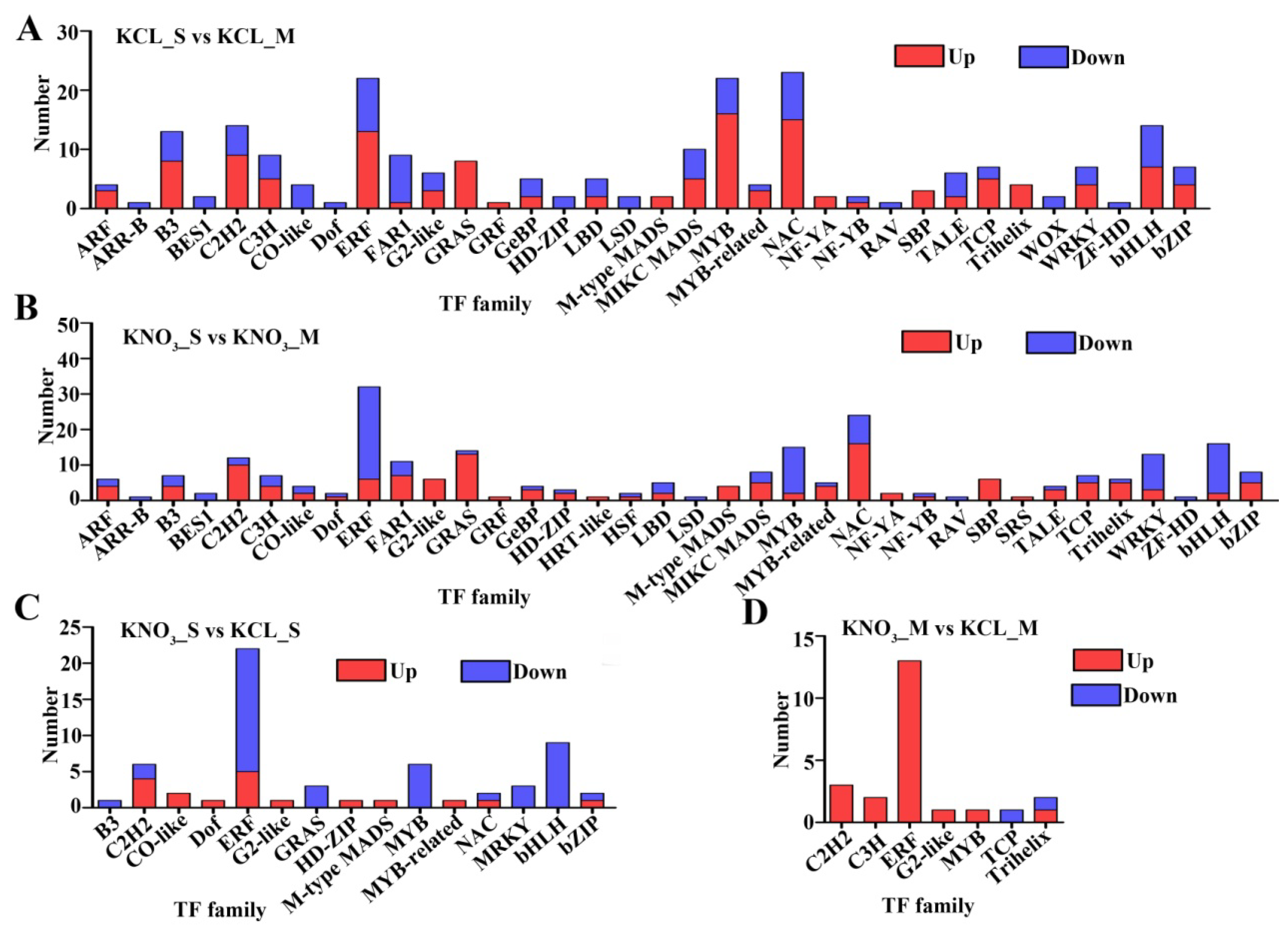
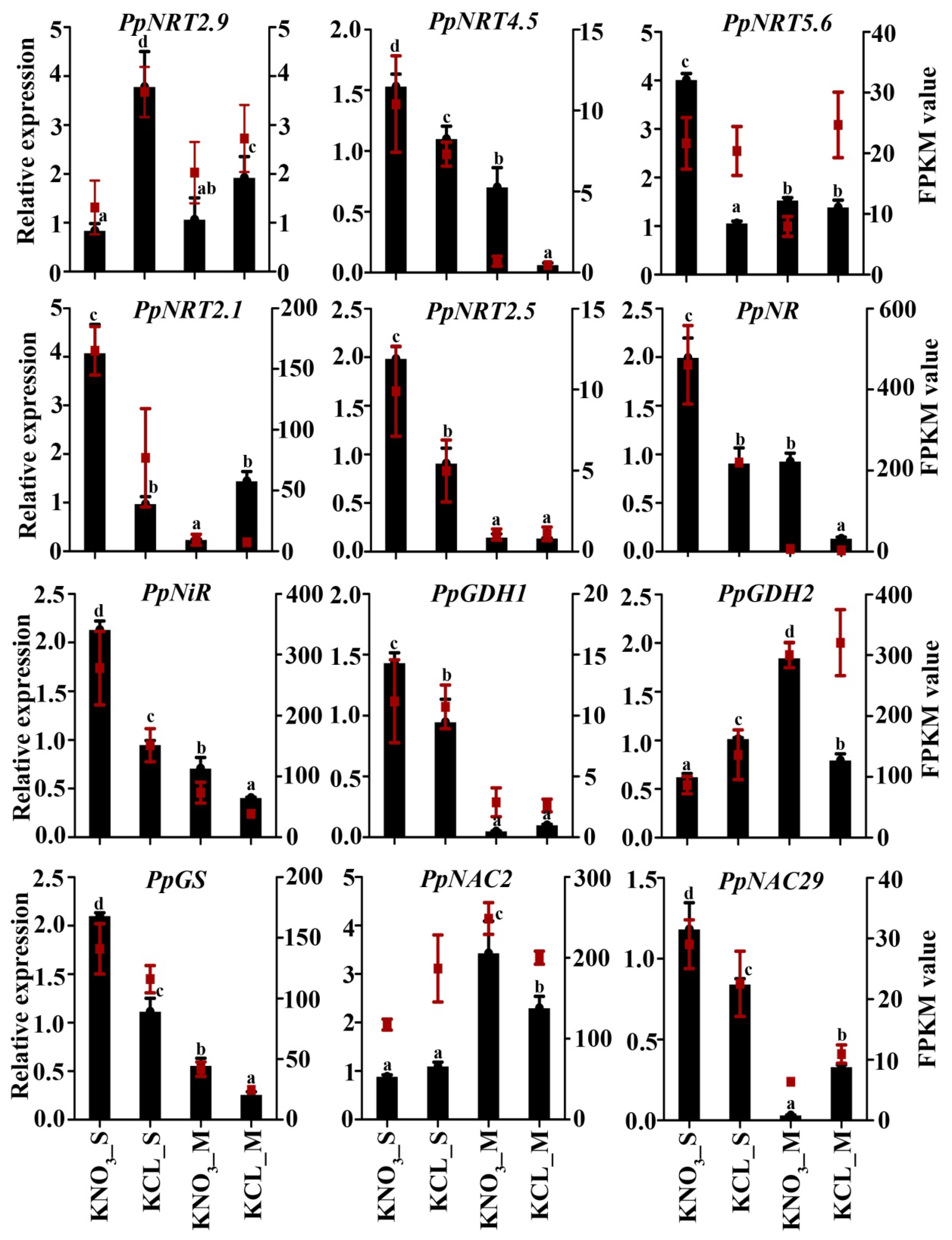
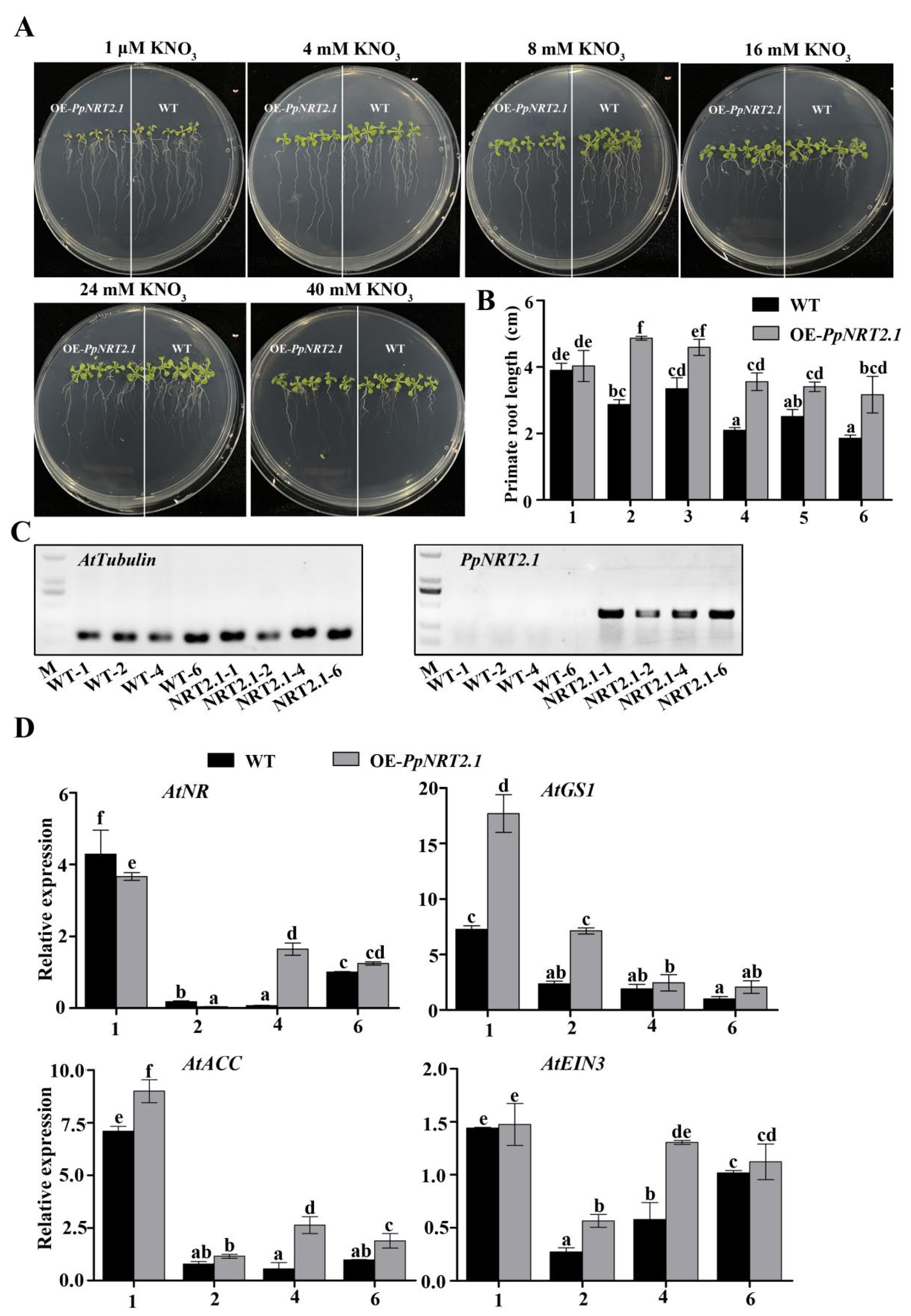

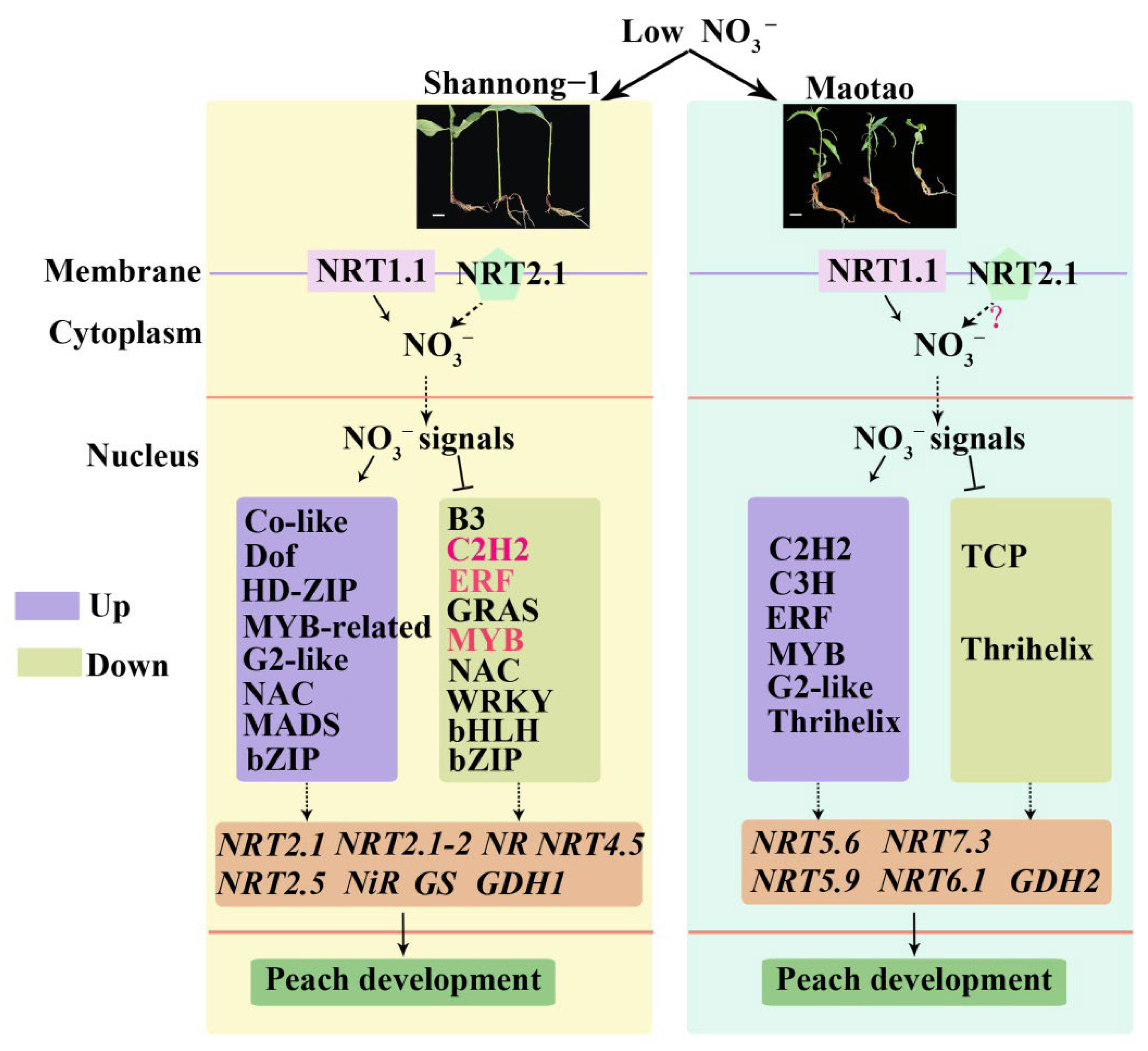
Publisher’s Note: MDPI stays neutral with regard to jurisdictional claims in published maps and institutional affiliations. |
© 2022 by the authors. Licensee MDPI, Basel, Switzerland. This article is an open access article distributed under the terms and conditions of the Creative Commons Attribution (CC BY) license (https://creativecommons.org/licenses/by/4.0/).
Share and Cite
Chen, Q.; Lian, M.; Guo, J.; Zhang, B.; Yang, S.; Huang, K.; Peng, F.; Xiao, Y. Comparative Transcriptome Analysis of Two Peach Rootstocks Uncovers the Effect of Gene Differential Expression on Nitrogen Use Efficiency. Int. J. Mol. Sci. 2022, 23, 11144. https://doi.org/10.3390/ijms231911144
Chen Q, Lian M, Guo J, Zhang B, Yang S, Huang K, Peng F, Xiao Y. Comparative Transcriptome Analysis of Two Peach Rootstocks Uncovers the Effect of Gene Differential Expression on Nitrogen Use Efficiency. International Journal of Molecular Sciences. 2022; 23(19):11144. https://doi.org/10.3390/ijms231911144
Chicago/Turabian StyleChen, Qiuju, Min Lian, Jian Guo, Binbin Zhang, Sankui Yang, Kexin Huang, Futian Peng, and Yuansong Xiao. 2022. "Comparative Transcriptome Analysis of Two Peach Rootstocks Uncovers the Effect of Gene Differential Expression on Nitrogen Use Efficiency" International Journal of Molecular Sciences 23, no. 19: 11144. https://doi.org/10.3390/ijms231911144
APA StyleChen, Q., Lian, M., Guo, J., Zhang, B., Yang, S., Huang, K., Peng, F., & Xiao, Y. (2022). Comparative Transcriptome Analysis of Two Peach Rootstocks Uncovers the Effect of Gene Differential Expression on Nitrogen Use Efficiency. International Journal of Molecular Sciences, 23(19), 11144. https://doi.org/10.3390/ijms231911144





